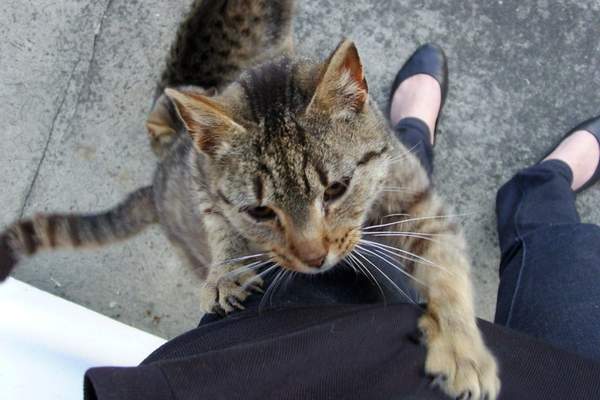All animals have their own habits, especially cats. Some cats drink out of the toilet while others scratch furniture. While cats can be cute and great pets, there are always downsides to any pet. And just like people, cats have their own personalities and behavior.
So, why does my cat climb me like a tree? It’s most likely because they’re craving attention, wanting to display dominance, or because they’re young and are therefore very light in weight, making it easy for them to climb you.
In this article, we’ll go over the many reasons for this behavior and how to resolve it. Just remember that every cat is different and some of these solutions might not work for you. You should always consult a professional if the behavior persists for anything that seems odd about their behavior. But if it’s an easy fix, hopefully we can help resolve your cat’s odd behavior.
Why Do Cats Like to Climb?
Cats have a natural inclination to climb, rooted in their evolutionary history and instinctual behaviors. In the wild, climbing serves multiple purposes for felines. Firstly, it provides them with an advantageous vantage point for observing their surroundings, aiding in both hunting and predator detection.
Climbing also serves as a means of escape from potential threats, allowing cats to retreat to higher ground where they feel safer. Additionally, climbing satisfies their innate need for physical exercise and mental stimulation. This behavior is not only instinctual but also contributes to the overall well-being of domestic cats, as it helps maintain their agility and provides an outlet for their predatory instincts.
Providing appropriate climbing structures in a home environment allows cats to express these natural behaviors and promotes a healthier and happier feline companion.
What Does Climbing Your Leg Look Like?

Climbing your leg probably seems obvious to spot but it can start from pawing (or even clawing) at your pants to full-on climbing. It quickly shifts from playfulness to something they know they shouldn’t be doing. This change is gradual, and you might not even notice it. If you entertain this behavior, it can swiftly evolve into a problem that will be much less simple to resolve.
Identifying the signs and reasoning behind this behavior, including instances of ‘why does my cat try to climb me,’ can be your best chance at halting it altogether. Our best advice is for you to listen to your cat and its needs. While some cats might climb your leg playfully, it could also be a sign they need something from you.
Climbing as a Kitten
This behavior is especially common in kittens because it’s easier to actually climb your leg when they weigh less than five pounds. Even with adult cats, they can choose to climb your leg out of their need for affection and attention. Maybe they think it’s time for dinner and want food. Or perhaps they want to play and can’t seem to get your attention otherwise.
Cats that feel neglected can quickly resort to more extreme behaviors to get your attention. Whatever their reasoning may be, they want you to stop focusing on what you’re doing and pay attention to them. This can easily be resolved by giving them what they want: attention. Sometimes all it takes is simply sitting down with them and giving them just that.
Examples include:
- Scratching their neck or chin
- Petting them either on the head or somewhere you know they like
- Rubbing their belly if they allow you to and like it
- Playing with them is also a great way to spend time with them
You’ll notice once your cat gets what they want, they’ll usually slip away, and you’ll wonder where they even are. If you notice this, you should go ahead and set aside time for them each day, so you won’t have to worry about this behavior again.
The Instinctual Need to Sharpen Claws

There’s also that instinctual need that all cats share of sharpening their claws. Whether it’s on your furniture or an actual scratching post, they’ll go about whatever way they can to sharpen them. And sometimes, that might just include your pants.
They’ll have an easier time sharpening their claws if you provide them with the tools to do so. If this is the reason for them climbing on you, then it’ll also be beneficial for them in the long run. I have my own scratching post corner for my cats and occasionally will spray it with catnip to keep their attention. Since then, I haven’t had this issue. Though, it could still persist.
Your issue may be a bit more dire. If this behavior has persisted for a month or a couple of months, your cat might have ingrained this behavior in its daily schedule. This is the perfect opportunity to set boundaries and tell them this is inappropriate.
Of course, cats have no idea what you’re saying but you can communicate in other ways. Raise your voice a little higher than normal and follow that with a loud sound, such as snapping your fingers. If you do this every time and give attention to the behavior, it should stop.
Just make sure you’re never violent towards them or use negative reinforcement. This will backfire quickly, and your cat may develop skittish behavior that is hard to revert. It will also make your cat frightened of you or not want to be around you.
Is Declawing a Solution?
Our recommendation is that you don’t declaw your cat, even if you’re at your wits end. It’s a common misconception that declawing a cat is similar to having your nails trimmed. Instead, it should be compared with removing the last bone of each toe.
It’s also not a complete solution to your problem. Yes, your cat will no longer be able to climb you, but they might be at an even higher risk for adopting skittish or fearful behavior.
Taking your cat to a groomer to have their nails trimmed is a much better solution. In fact, it’s considered good hygiene to trim your cat’s claws regularly. If you’re not comfortable doing that yourself, a groomer is a much safer option for both you and your cat.
Energy Exertion
Your cat might also not be very active. If your cat’s schedule is basically “eat, sleep, poop,” then you might want to consider helping your cat become more active as this behavior in itself could also transform into something worse if you don’t step in quickly enough.
Your first step into helping your cat become more active should be to see if they have a favorite toy. Younger cats have more energy typically and if you leave balls lying around, odds are they’ll be active on their own (especially at night). If you have an older cat, you might need to take it upon yourself to help them become more active.
Dominance in Cats
If your cat isn’t climbing you for any of these reasons, it could also have to do with dominance. You’d know if you’ve ever had more than one cat in the same place that there is always an alpha cat – a cat that naturally takes the lead and wants what they want when they want it.
Although “alpha cats” isn’t completely factual as it is with a pack of wolves, the idea is the same; there is a cat that has more dominant traits than others.
Some of this behavior can be altered over time and with training, but sometimes it’s just their personality. If you have a climber that’s an alpha cat, they might just be climbing up your leg to show you that they’re the dominant cat. They know you don’t like it and know they shouldn’t be doing it, but they do it anyway.
How to Fix This Behavior?

The best way to stop this kind of cat from climbing your leg is to first address the problem: that it’s most likely out of a need for something else. Try playing with your cat for at least an hour every day and see if the problem persists.
This can include supplying them with a scratching post, having them chase a string around the house, or even give them affection. Figure out which playstyle best suits your cat and try to interact with them like that regularly.
That Didn’t Work, Now What?
If all else fails, you should always consult your local vet or even make an appointment for a behavior consultation. It is possible to train cats to alter behavior, but you’ll need a professional to have the best results.
Just remember that negative reinforcement does not work on cats like it might on other animals. You don’t want to frighten your cat and cause them to develop skittish or fearful behavior. Simply tell them “no” loud and clear and then clap your hands. Eventually, they’ll come around to associating that sound with them doing something wrong.
It’s helpful to also reward good behavior while rewiring bad behaviors. Some good behaviors include waiting patiently while you feed them, keeping quiet at night so you can sleep, etc. Treats are an easy way to reward these behaviors and cats love treats especially.
Conclusion
It might seem annoying to you when your cat climbs your leg, but just remember most cats aren’t doing it for that reason. Take it as a sign that there’s something you need to be doing for them. Cats might not be able to communicate in the same way we communicate with each other, but they have other ways of saying what’s on their mind. Learn to listen to that.
And just one last reminder: if none of our advice helps your cat, make sure to promptly visit with your local vet or professional and correctly diagnose your cat. Sometimes, odd behavior can be a symptom of something more serious.

